AudioThing
Showing 21–30 of 30 results
Showing 1 - 10 out of 10
Page 0 out of 0
| Rating | Image | Product | Price |
|---|---|---|---|
|
4.66 SOUND QUALITY FEATURES VALUE FOR MONEY EASE OF USE |
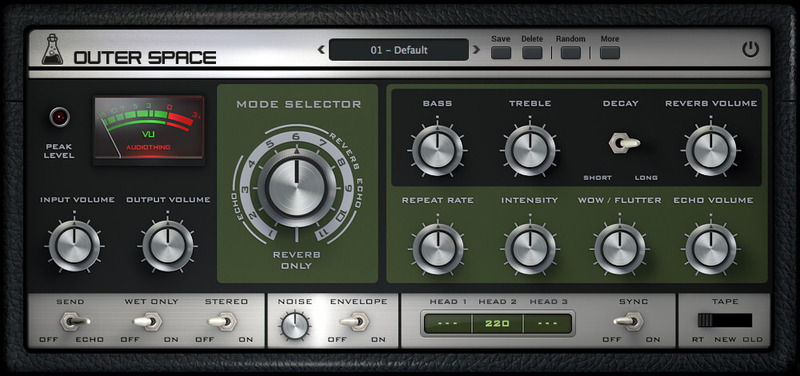 |
Outer SpaceOuter Space is a faithful emulation plugin of a famous vintage tape echo made in the early seventies. As the original unit, Outer Space features an echo section with three playback heads and a spring reverb tank. We have modelled three different tape frequency responses and saturations, along with all the analog imperfections of tape recording/playback. We’ve also modelled the ballistic response of the delay rate (repeat rate) which can create eerie pitch shifts (due to the Doppler effect), one of the classic tape echo-based sound effects. Specifications
Windows 7, 8, 10 (64 bit)
OS X 10.7 – macOS 10.14
|
Price History: Outer Space 44.85 $ |
|
4.64 SOUND QUALITY FEATURES VALUE FOR MONEY EASE OF USE |
 |
Wave BoxWave Box is a dynamic dual waveshaper plugin that can be used for both symmetrical and asymmetrical distortion. A waveshaper is a type of distortion in which the input signal is mapped to the output by applying a fixed or variable shaping function. Specifications:
Symmetrical vs Asymmetrical Waveshaping
When a shaping function is applied equally to both the positive and negative part of the signal (symmetrical waveshaping), odd harmonics are generated. Instead, when a shaping function is applied only to either the positive or the negative part (asymmetrical waveshaping), even harmonics are generated. In Asymmetrical Mode (± on), the first shaping function is applied to the positive part while the second shaping function is applied to the negative. The Bias, in this case, controls an offset added between the positive and negative part of the signal. In Symmetrical Mode (± off), both shaping functions are applied to the whole signal. The Bias, in this case, controls the mix between the two functions. SYSTEM REQUIREMENTS
|
Price History: Wave Box 31.85 $ |
|
4.62 SOUND QUALITY FEATURES VALUE FOR MONEY EASE OF USE |
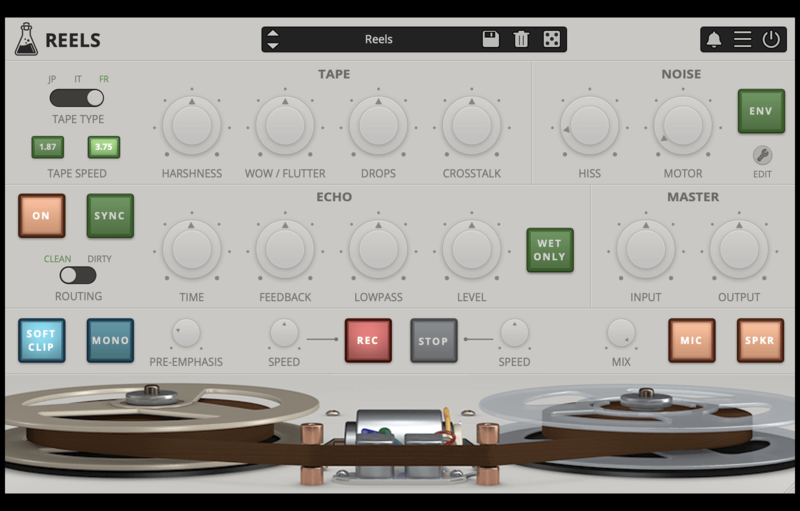 |
ReelsREEL TO REEL Reels is a tape emulation plugin with built-in echo section and tape-stop effect. Based on an old Japanese portable tape recorder with a very distinct Lo-Fi analog sound, Reels emulates all the imperfections of consumer reel-to-reel recorders. We have modeled three different 1/4” tape frequency responses and saturations, along with all the analog imperfections of tape recording / playback. Reels will add a very rough retro analog sound to your mixes. If you are looking for a Hi-Fi mastering tape emulation, this is not the plugin for you! SPECIFICATIONS
PORTABLE TAPE RECORDER Reels is based on a vintage Japanese reel to reel, ironically marked as High Fidelity, found in a distressed state at a local flea market. Most of these consumer tape recorders, also due to their age, produce has a very rough Lo-Fi analog sound. During recording or playback, the motor noise somehow bleeds in, along with the usual tape hiss, limiting the actual bandwidth available on the tape. Reels recreates all the imperfection of consumer reel-to-reel vintage recorders, including:
TAPE STOP When pressing stop on a reel-to-reel player, the tape doesn’t stop immediately. Instead, it slows down creating a pitch down and fade out effect. You can replicate this effect with Reels, and you can also control the speed of the tape stop. TAPE MODELING We’ve modeled three different tape types, from ruined to NOS (new old stock) state. The tape types are named after the country of origin: JP (Japan), IT (Italy), FR (France). JP Used tape but with an overall better frequency response IT New old stock but with a limited frequency response FR Overused and badly stored, very bad frequency response Each tape will affect the sound in different ways, especially at higher feedback settings when using the Echo section. WOW/Flutter, Ducking, and other parameters will also change according to the selected tape, creating different amount of pitch and volume changes.
|
Price History: Reels 38.35 $ |
|
4.62 SOUND QUALITY FEATURES VALUE FOR MONEY EASE OF USE |
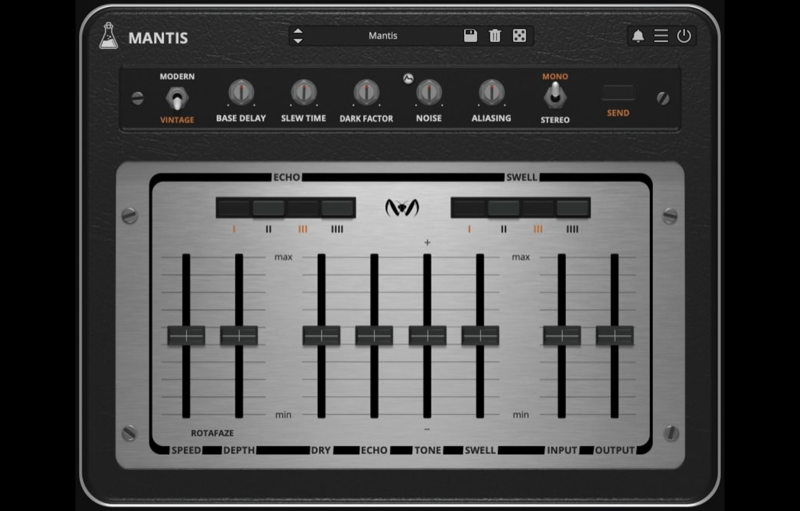 |
MantisVintage BBD Echo Mantis is a plugin that emulates a rare BBD (bucket-brigade device) delay/echo unit of the 70s, faithfully recreating its warm and analog sound. As the original unit, Mantis features an echo section with four taps and four swell selectors. It also features the rotafaze section, a modulation that can mimic the wow/flutter of a tape echo or turn the unit into a unique chorus-delay. The Mantis has eight TDA1022 chips, often associated with shorter and more precise delay, these chips are perfect for organic analog slap-back echo. The base delay time is fixed on the hardware, but in the plugin in “vintage” mode, the base delay can be set in the range of 0.512ms up to 51.2ms (as each chip has 512 stages). In a BBD circuit, the frequency response changes depending on the base delay: brighter at faster rates, and darker at slower rates. To avoid these limitations, AudioThing also included a “modern” mode, which allows a base delay of up to 1sec (free) that is also syncable to the Host/DAW tempo. Carlsbro Mantis Built in the early 70s, the Carlsbro Mantis was probably one of the early, but less common, commercial BBD echo/delay units. BBD-based delays were a good alternative to the bulky and fragile tape echoes, although with several limitations. The Mantis had the delay time fixed, but it was possible to adjust it by opening and tuning each BBD trimmer. It was also quite noisy, especially when using all the taps and swells. BBD Chips The BBD (bucket-brigade device) technology was developed by F. Sangster and K. Teer of the Philips Research Labs in 1969. BBDs are essentially a series of capacitors that pass an analog signal down a chain in discrete steps, like a bucket brigade passing buckets of water. The clock rate (base delay) determines the rate at which the signal is passed down the chain of capacitors. Capacitors are not perfect and can experience some leakage. This results in a gradual loss of information as each new capacitor in the chain receives slightly less signal than the previous one. As a result, longer delay times on these devices can cause the signal to become distorted and darker with each repetition. Features
Windows
Mac
|
Price History: Mantis 38.35 $ |
|
4.6 SOUND QUALITY FEATURES VALUE FOR MONEY EASE OF USE |
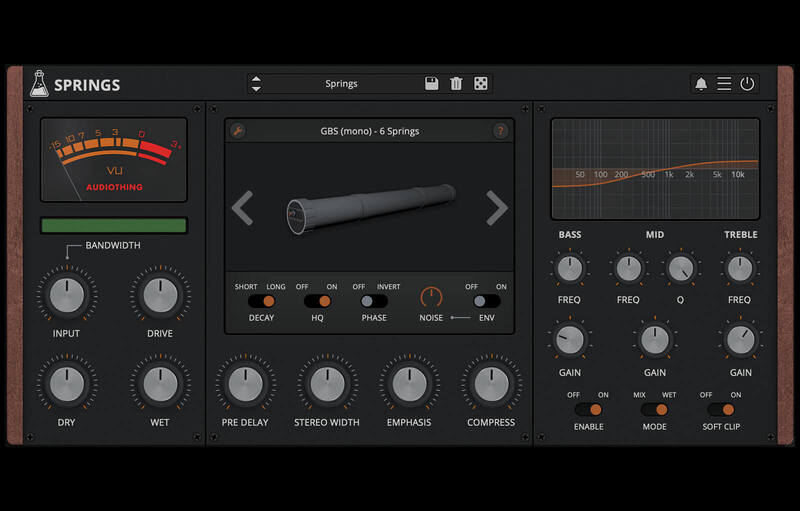 |
SpringsVINTAGE SPRING REVERB + BAXANDALL Springs is a plugin which features a collection of vintage spring reverbs paired with an authentic Baxandall EQ emulation. Springs features emulations from 8 types of spring reverbs, ranging from a long 6-spring pipe to a tiny battery-powered single-spring unit. We have used a combination of convolution and modelling to recreate the vintage character of each reverb. MAIN SPECIFICATIONS:
Spring reverbs were usually paired with tone stacks from guitar amplifiers. Springs features one of the most iconic and unique sounding tone stack equalizers: the Baxandall EQ. A classic Baxandall tone stack usually features just the bass and treble bands, but we have also added a Mid band (with control over the Q). SPRING REVERBS We have collected and emulated several spring reverbs. Each one with its own sound.
BAXANDALL EQ The Baxandall EQ is a classic type of EQ, mostly found in guitar amps, and usually limited to just a single tone control or two bands (bass and treble). We have added a third band (mid with Q control) to shape the reverb sound further. One important characteristic of the Baxandall EQ is that the bands interact with each other. This may seem like an unwanted behavior, but it’s one of the reasons why the Baxandall EQ curves are smooth and musical. HOW SPRING REVERBS WORK A spring reverb is an electromechanical device that uses transducers/pickups with steel springs in order to simulate the reflections of a reverb. The input signal is passed through a transducer to one or multiple springs, the vibrations are then captured by an output transducer on the opposite side. Using multiple springs with different sizes and different thickness can create a more interesting and rich reverb sound. Windows XP SP2 or later / OSX 10.6.8 or later Intel Core 2 Duo 2GHz or equivalent 2 GB RAM / 500 MB HD Screen resolution: 1024×768 VST2, AU, or AAX 64-Bit ONLY |
Price History: Springs 44.85 $ |
|
4.6 SOUND QUALITY FEATURES VALUE FOR MONEY EASE OF USE |
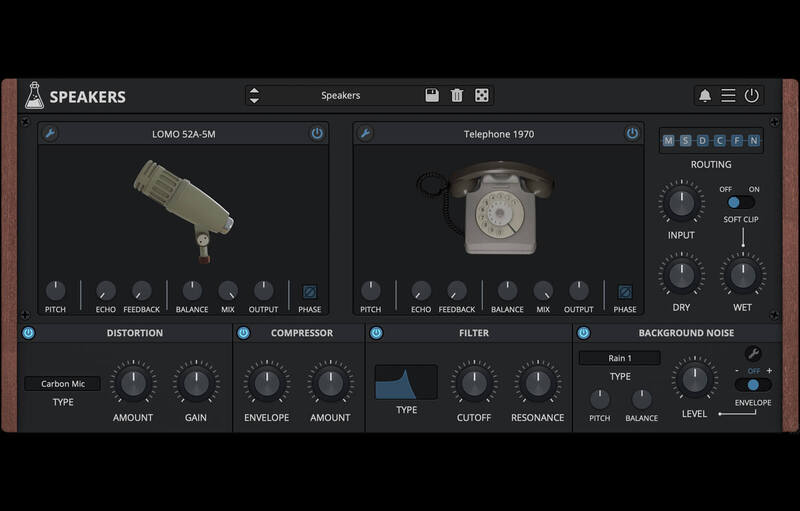 |
SpeakersSpeakers is a plugin effect designed to emulate a wide range of loudspeakers and microphones using our state-of-the-art convolution engine. Shape any sound like it’s being played by an old telephone, radio, or classic cabinet; or shape it like it’s being recorded by a vintage ribbon microphone or even a toy recorder. Speakers features a freely configurable effects chain, comprising compression, distortion, and filtering, as well as an array of looping background noises for setting the sound in a variety of environments. Speakers is a zero-latency* post-production dream plugin. No iLok or any other dongle required! Speakers features:
EQUALIZERS Clicking the spanner button at the top left of either panel reveals a five-band EQ – low and high shelves and three parametric bands – for shaping the frequency response of the Microphone and Speaker emulations. Drag the nodes around to set band frequencies and gains, scroll the mousewheel over a node to tweak the Q, double click to reset the band. DISTORTION / DEGRADATION Speakers features 15 distortion and degradation algorithms for post-production and sound design. Distortion: Carbon Mic, Classic Drive, Diode Clipper, Foldover, Soft Drive, Tape, Valve. Degradation: Bit Crusher, Clicks, Drops, GSM, Interference, Quantization, Robotization, Telecom. ROUTING The Routing panel enables limitless reordering of Speakers’ signal flow. To move a module, simply drag it left or right. The Input module marks the point at which the source signal enters the signal path, disregarding everything to the left. This can be useful for, for example, having the Noise pass through certain modules prior to being joined by the input signal further down the path.
SYSTEM REQUIREMENTS PC
MAC
|
Price History: Speakers 64.35 $ |
|
4.58 SOUND QUALITY FEATURES VALUE FOR MONEY EASE OF USE |
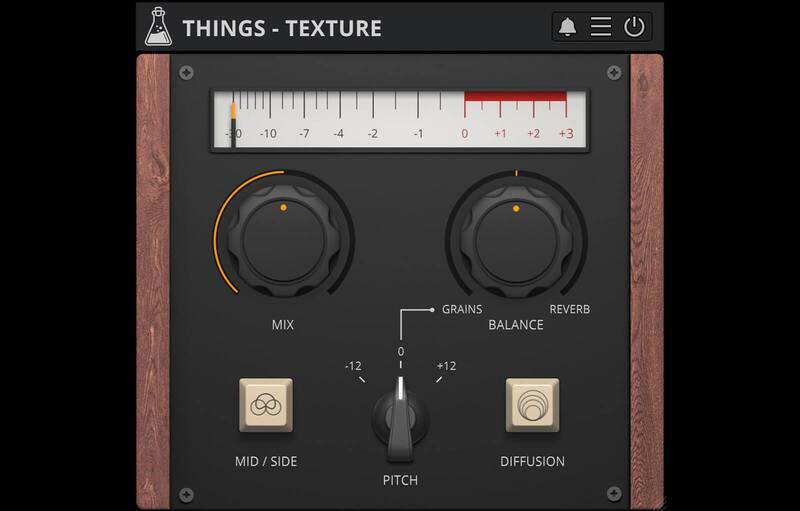 |
Things – TextureGranular Reverb The first in the series is Texture, an easy to use granular reverb with pitch shifting and mid/side mode. Texture can transform any sound into an ambient soundscape, or add that drone vibe to your tracks. This plugin was inspired by the techniques used in the soundtrack and sound design of the award-winning indie game The Swapper. Mid/Side What is Mid / Side? The Side channel instead contains the difference between the Left and Right channels. Boosting the Side channel results in a more spacious or wider sound. Mid / Side Mode MAIN FEATURES
PC
MAC
Linux
|
Price History: Things - Texture 12.35 $ |
|
4.56 SOUND QUALITY FEATURES VALUE FOR MONEY EASE OF USE |
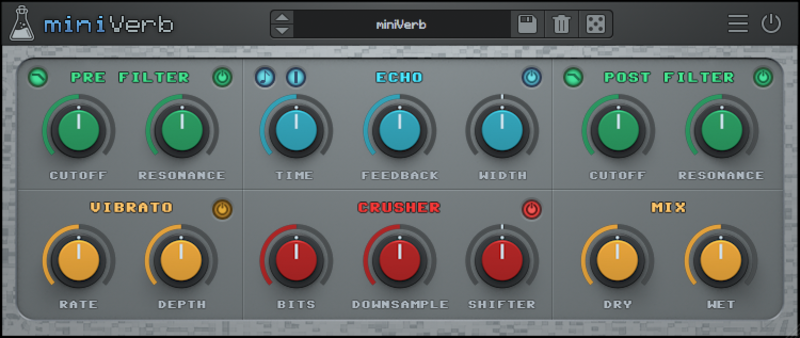 |
miniVerb8-BIT/CHIPTUNE ECHO REVERB EFFECT miniVerb is an 8-bit/chiptune and lofi reverb effect inspired by the sound of 80s game consoles and retrocomputers. Early consoles didn’t have much power for DSP effects, so the video game composers at that time had to improvise. The most common way to add a sense of space/reverb to the sound was to sacrifice one of the internal tracks to play a delayed version of the original sound, essentially using a slapback echo to add depth. The technique evolved and eventually, consoles started to take advantage of more power for real internal effects. miniVerb recreates that classic digital echo/reverb sound, made famous by iconic consoles such as the NES and SNES, topping it with two flters (post/pre), vibrato, and crusher (bit crusher, downsampler, pitch shifter). Features:
CLASSIC CONSOLES miniVerb was inspired by the sound of classic game consoles and retro computers of the 80s and 90s. For even more 8-bit/chiptune sounds, check out our synthesizer plugin miniBit. ECHO SECTION AND TIPS The Echo Section can be used to simulate the tricks used in early video game consoles to add a sense of space/reverb to the sounds. The most common way was to sacrifice one of the internal tracks of the sound chip to play a delayed version of the original track, essentially creating a slapback echo effect. To achieve this NES-like reverb sound, you can use a single delay line, very short time, no feedback, and width set to mono. To simulate a 90s fake reverb/echo (like the SNES) instead, you can play with longer times and add some feedback to simulate a reverb tail. For a more modern approach, you can switch the Echo to Double Delay Line by clicking on the blue button (in the top-left corner) and increase the width to a wider setting. Note: This plugin is 64bit ONLY! Minimal Requirements PC Requirements:
Mac Requirements:
Note: This plugin is 64bit ONLY! |
Price History: miniVerb 12.35 $ |
|
4.56 SOUND QUALITY FEATURES VALUE FOR MONEY EASE OF USE |
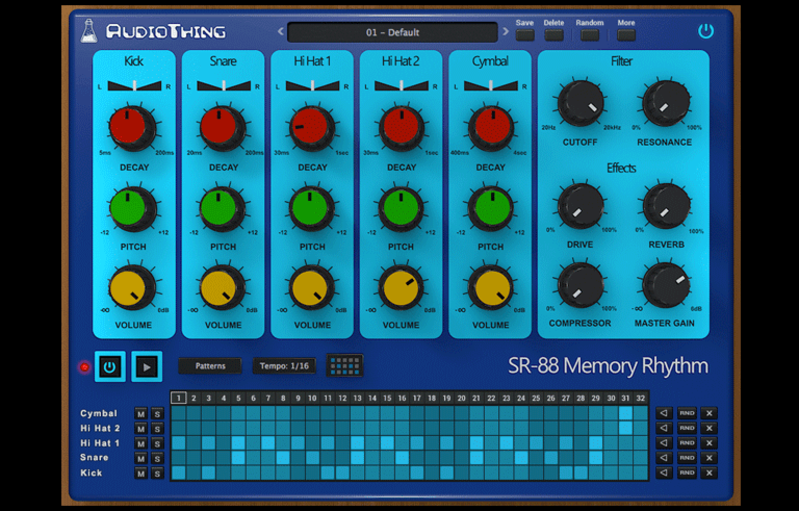 |
SR-88SR-88 is a sample-based plugin emulation of the Sound Master Memory Rhythm SR-88, a rare analog drum machine from the 80s. The instrument features 5 classic analog sounds which can be pitched, panned or mixed independently:
You can additionally shape the sound with the Low Pass Filter (Zero Delay Feedback), Overdrive, Compressor and Reverb. The sequencer lets you easily build patterns that can be dragged and dropped to your DAW/host. Specifications
Windows 7, 8, 10 (64 bit)
OS X 10.9 – macOS 12
|
Price History: SR-88 18.85 $ |
|
4.52 SOUND QUALITY FEATURES VALUE FOR MONEY EASE OF USE |
 |
NoisesNoises is an experimental instrument with a playful and inspiring interface, designed to bring a vast world of noise into your music and audio production. Noises is the fourth plugin we developed together with German composer and “that guy with the sweaters“ Hainbach. He crafted hundreds of recordings of rare vintage measurement and tape equipment, analog synths, strange field recordings, electro-acoustic and magnetic field experiments, and more in his lab to create this creative noise instrument with us. It is designed to be fast and inspiring to use, with a big dial at its center inviting you to search for sounds and a sequencer to make them music. This results in a minimum of clicks for a maximum of sound. Used subtly, it adds coherence to your tracks. Used creatively, this can be the basis for whole tracks. It is easy to create modern scores for film, games, and podcasts with it and a quick tool for sound design. If you need a break, put it on and relax to carefully curated noise sequences. PC
MAC
|
Price History: Noises 44.85 $ |



